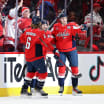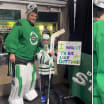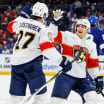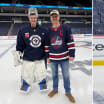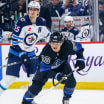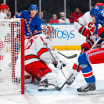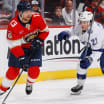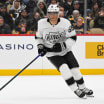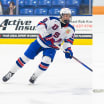It's about 40 miles from New Rochelle, New York, to West Orange, New Jersey, home of South Mountain Arena.
It's not an easy drive at various times of day and can be a nightmare during rush hour.
But no matter how long the trip took, a young Kevin Shattenkirk would not be deterred from making it countless times, doing whatever he could to develop the skills that would eventually take him to the NHL.
New York youth hockey helping to fuel NHL dreams
Rangers defenseman Shattenkirk has seen game's growth boost others from area

© Jared Silber/Getty Images
When Shattenkirk, in his eighth season in the League and first with the New York Rangers, started playing hockey as a boy, he skated locally at Playland in Rye, New York, for the New Rochelle Lightning, a youth organization founded in 1981. The youngest of three brothers (Keith, Eric), Kevin had hockey dreams that were too big for Westchester County.
RELATED: [Complete NHL Winter Classic coverage]
The top programs at the time were in New Jersey, so Kevin and Keith joined the New Jersey Devils Youth Hockey Club to face the best competition and have the best chance of improving. That meant a heavy commitment and sacrifice, one Shattenkirk and his brother, who went on to play four years at Princeton University, were more than happy to make.
"There were a lot of days where we would just get home from school, grab your hockey bag and get down to Jersey," Shattenkirk said. "We both would ship down there and spend our nights there doing homework and playing hockey."
Shattenkirk's odyssey was familiar to many youth hockey players growing up in the New York City area. Today, the hockey on the grassroots level has grown to where numerous future NHL players have been able to stay in New York, Westchester and Long Island to learn the game. Kids are better trained and not only making it to the NHL, but excelling.
"It's great now to see how the area has changed so much around where I grew up and how much opportunity there is for young players to play on competitive teams," said Shattenkirk, a defenseman who plays his home games at Madison Square Garden, about 20 miles from New Rochelle. "It wasn't there at the time, but toward the end of that period of my hockey career it's really started to pick up."
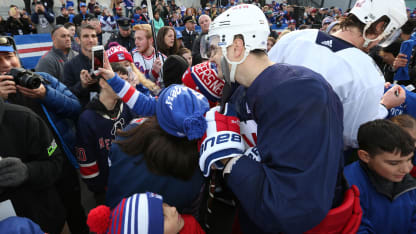
© Jared Silber/Getty Images
Shattenkirk will play on an even larger New York City stage when the Rangers face the Buffalo Sabres in the 2018 Bridgestone NHL Winter Classic at Citi Field on Jan. 1 (1 p.m. ET; NBC, SN, TVA Sports). It will be Shattenkirk's second Winter Classic in as many years; he helped the St. Louis Blues defeat the Chicago Blackhawks 4-1 at Busch Stadium in 2017.
"Last year was one of the better hockey experiences of my life," Shattenkirk said. "Not only is it a hockey game, but it's a chance for your family and friends to share this great moment with you. These are the moments during your NHL career that you really have to appreciate, to take a step back and realize that this game has brought you to some great places and brought the opportunity for your friends and family to share a lot of experiences with you."
CBS Sports Network college hockey analyst Dave Starman has been a coach at nearly every level of the sport, including with the New York Junior Bobcats of the Atlantic Junior Hockey League and the New York Apple Core of the Eastern Junior Hockey League. He credits the American Development Model (ADM), a nationwide player-development program for youth hockey associations, for laying the framework for coaches with regard to reference material, practice planners and ideas.
Starman said the ADM, created by USA Hockey in 2009 and adopted by the U.S. Olympic Committee for all sports in 2014, has had a big impact on youth hockey in the New York area because it has made the coaches better.
"The coaching education program has gotten better though USA Hockey," he said. "It's empowered them to be able to go out and do it right.
"We have shifted from the philosophy that you can coach a Mite team the same way you can coach a Midget team into realizing that 8-U (age eight and under) is 8-U and 10-U (age 10 and under) is 10-U, and 12-U (age 12 and under) is 12-U. Because of the age-appropriate training that we're doing, kids are getting taught what they should be getting taught when they should be getting taught it, and it's preparing them for success at their next age level. That is to me the biggest difference from when I was growing up."
Hockey's evolution in the New York area is evident throughout the League. New Jersey Devils defenseman Steven Santini played for the Westchester Express minor hockey team growing up in Bronxville, New York. Carolina Hurricanes defenseman Brett Pesce, a native of Tarrytown, began play at the age of 3 and his first youth hockey team was the Westchester Vipers.
On Long Island, Boston Bruins defenseman Charlie McAvoy (Long Beach), the No. 14 pick in the 2016 NHL Draft, got started with the Long Beach Apple Core program. Columbus Blue Jackets forward Sonny Milano (Massapequa), chosen No. 16 in 2014, skated with the Long Island Royals of the Tier 1 Elite AAA organization in Kings Park.
San Jose Sharks forward Kevin Labanc was born in Brooklyn before his family moved to Staten Island. He played for the Staten Island Rangers of the New York State Amateur Hockey Association before skating for the New Jersey Rockets at RWJBarnabas Health Hockey House, the Devils practice facility in Newark.
St. Louis Blues rookie center Tage Thompson, chosen in the first round (No. 26) in 2016, grew up in Oyster Bay and was McAvoy's teammate with USA Hockey's National Team Development Program in 2014-15.
There are more on the way. Defenseman Adam Fox (Calgary Flames, No. 66 in 2016) was raised in Jericho and forward Jeremy Bracco (Toronto Maple Leafs, No. 61 in 2015) in Freeport.
"Nowadays there's just so many kids around coming up," Shattenkirk said. "There's so many guys in the League that I feel like we're that first generation of New York and Westchester players."
Becoming the next Shattenkirk was Santini's ambition when he was training at Brewster Ice Arena. Santini's father, Steven, helped build the arena and runs New York Apple Core's top junior team.
"You look at a guy like Kevin, that was the goal," said Santini, a USNDTP alum (2011-13) before playing at Boston College. "I wanted to go to the NDTP, I wanted to go to college and I wanted to play in the NHL. He paved the route and said it doesn't have to be just Massachusetts and Minnesota guys. For me, I don't know if it was inspiration, but it was kind of, 'If he can do it, I can do it."
The New York Islanders winning the Stanley Cup four straight times (1980-83) was the launchpad for young Long Island residents dreaming the same dream. Twin brothers Peter and Chris Ferraro (Port Jefferson, New York) were chosen by the Rangers in the 1992 NHL Draft, and the forwards became the first Long Island natives to break into the League in 1995-96. They are skills coaches at The Rinx (Hauppauge) and Northwell Ice Center (East Meadow), the Islanders practice facility.
"That really raised our interest level," Chris Ferraro said of the Islanders dynasty. "With the combination of our parents being in the sporting goods business it was a really exciting time on Long Island, and that jump-started our careers on a local level."
However, there was little incentive for the Ferraro twins to stay on Long Island, so they spent summers traveling across the United States and Canada for elite training. Their father, Peter, often drove to Philadelphia so his sons could play for the Little Flyers of the Eastern Hockey League. Years later, the family rented a house in Marion, Massachusetts, so the twins could attend prep school and play at Tabor Academy. In 1990, they moved to Dubuque, Iowa, to allow Peter and Chris to play at the Junior A level in the United States Hockey League.
"It seemed like back then my family was ahead of the times," Peter Ferraro said. "My father's mindset back then was you can prove yourself locally, but that's not going to get you to the highest levels. We needed to go to other parts of the country and Canada, and make a name for yourself there. That's what really helped catapult our career."
Mike Komisarek (West Islip, New York), a defenseman chosen by the Montreal Canadiens with the No. 7 pick in the 2001 NHL Draft, played 11 seasons in the League and is the only Long Island native to play in an NHL All-Star Game (2009).
"I was a perfect example of a kid from Long Island, immigrant parents, who had a little bit of talent but loved the game and did whatever it took to get to the next level," said Komisarek, a player development coach with the Sabres.
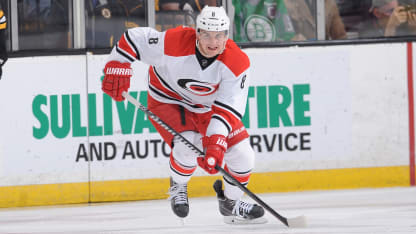
© Brian Babineau/Getty Images
"For a young player growing up, for me it was Peter and Chris Ferraro or [defenseman] Rob Scuderi (a Syosset, New York, native who played 783 NHL games and won the Stanley Cup with the Pittsburgh Penguins and Los Angeles Kings). You see those guys playing at elite programs across the country and you get a sense if they can do it -- and they're right down the street from me -- maybe I can play for one of those programs. We did our part and maybe some kids saw us and were like, 'Wow, we want to play because those guys can make it.' Hopefully there's a new generation that's seeing us having success playing in the NHL, college hockey, and say, 'Hey, we can do this, too."
McAvoy did it. He starred at Boston University for two seasons before making a splash by getting three assists and averaging 26:12 of ice time during the Bruins' six-game loss to the Ottawa Senators in the 2017 Eastern Conference First Round.
His father, Charlie, a plumbing and heating contractor, helped put a rink on the second floor of Long Beach Arena, where Charlie Jr. started skating when he was 3. McAvoy's game developed with the Long Beach Apple Core program and the Long Island Gulls, playing for the latter with Bracco, whose father, Mike, was the coach.
"He had such a wealth of knowledge of the game and kind of the direction it was going," McAvoy said. "Most of the things that we did were all skill development, lots of skating development and stuff like that. I felt like we were kind of doing stuff that not a lot of people were, a lot of pass-first when little kids might not have that vision. We developed that at a really young age, that passing. That kind of group speaks for itself, and the coaches are what we have to be thankful for. They put a foundation in us at a young age."
Having the 2018 Winter Classic in New York could open doors for more young hockey players in the area. During an outdoor practice in Central Park on Dec. 2, the Rangers gave 50 tickets for the game to the nonprofit Ice Hockey in Harlem program so 40 kids and 10 coaches could attend. Ten players from the program will also play on an auxiliary rink at Citi Field before the opening face-off.
"These events can do so much for the youth programs and just the buzz around the area," Shattenkirk said. "It's great for the kids in the city who are playing hockey. It's great for the kids in the surrounding areas who are playing hockey to hopefully have an opportunity to go to the game. But if not, just watch it and realize how special hockey is and how much fun you can have with it."
